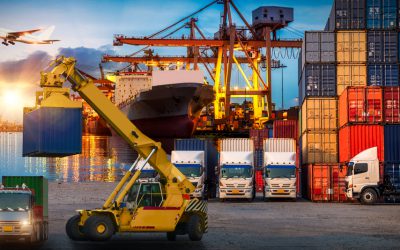How Digitization and E-Commerce are Reshaping Freight Forwarding?
E-Commerce is currently in the process of transforming the world of logistics from the ground up. In fact, with the help of a unique set of standards, E-Commerce has changed the outlook of logistics and supply chain to make it more dynamic, coordinated and tech-friendly than ever before. One area of particular note is the way digitization and E-Commerce have reshaped the freight forwarding sector during
Let’s have an overview of the impact of digitization and E-Commerce on freight forwarding industry and understand what the future holds for modern-day freight forwarders.
The Industry Pressures of E-Commerce and the Call for Greater Tech
Over the last few years, the freight forwarding market has enjoyed a steady and noticeable growth and this trend is not limited to North America. Freight forwarders, all over the world, have been incredibly busy over the last few years due to affordable freight forwarding rates, low oil prices and excess capacity issues. The scope of freight forwarding services has become quite similar to the way E-Commerce sites move their products.
Low oil prices and capacity issues have historically been influential in the market. In 2016, although forwarders experienced tangible growth, they still reported lower year-on-year revenues.
Economist, David Buckby sees the future of forwarders as being at the whims of the Trump presidency. He theorizes that higher global trade would open new avenues for the freight forwarding market. However, since the Trump administration has been elected largely for its protectionist stances, this is not likely.
Similarly, John Manners-Bel, CEO of Transport Intelligence, has also criticized the current fragility of the sector. He contends that the industry will trend towards being increasingly unable to meet technological demands as well as rely more and more on regionalization and near-sourcing. He believes this to be the heart of the problem. He has also stated his belief that “political, economic and technological pressure will continue to shape the industry in the coming year.”
Transport Intelligence has also made several comparisons between top and middle-rung players in the market and found that margin pressures will only intensify in the next five years. They report that there is broad demand for more (and better) tech in the freight forwarding space to allow for better relations with shippers. And while it is clear that middlemen may be able to ride out the drastic change to the digital supply chain, analysts like Alex Le Roy predict a “race for scale amongst the startups.”
Digitization
It is clear that digitization may be a valid path forward for the freight forwarding market. But, when considering how customer appraisal of the market has radically shifted, it may be the only path forward.
Millennials are quickly becoming one of the largest generations in the workforce. By 2020, the Millennials are expected to make up 35% of the workforce (the same as Gen X.) This is significant when considering that this is a demographic that has come of age using online interfaces for business and pleasure. They may, therefore, favor forwarders that use technology to streamline their business practices.
Indeed, freight forwarders have not ignored these facts.
After conducting a survey, Cathy Morrow Roberson–President of the Logistics Trends & Insights consultancy–reported that 92% of respondents felt that digitization adds value and 58% of shippers announced that they would digitize in the next five years. And 58% of respondents also stated that they felt the new digitization would not eliminate traditional freight forwarders.
Instead, the old and the new may work much better together. People with close eyes on the freight forwarding sector can already notice profitable partnerships between the two groups. And this makes good sense. Traditional freight forwarders with clear access to an online freight marketplace can allow them digital solutions not previously available.
Just look at DHL and its online marketplace. CILLOX is DHL’s online platform whose main function is to match full truckload and less-than-truckload shipments with other available transportation providers.
Morrow Roberson foresees a leveling of the playing field due to the push for digitization. She claims that the people who stand to gain from the move are “not only forwarders but also shippers of all sizes. Shippers can take advantage of numerous online marketplaces such as Freightos to obtain a rate, book the freight and track it from beginning to end.”
Continued Pressure on the Industry and More Visible Technology
Despite the digital revolution, making an outright switch from traditional to advanced freight forwarding may still be challenging for the industry. There is still a long way to go and the sector has been previously hobbled by events as serious as cyber-attacks, which hindered many in the sector’s goal of achieving transparency.
The response from many was to boost more visible tech into the market. Examples include DHL’s Ocean View, which provides real-time tracking updates on maritime deliveries as well as DHL’s SupplyWatch, which is a program that can send alerts for supply chain disruptions.
But, even with these brave new steps forward, many have noted that margins are still too thin for most in the freight forwarding business. Many are hoping to see more profit soon.
There is one very important thing to consider here that how the industry has seen massive growth in capacity while the pricing and revenue generation have been below par. It is also noticeable that what was gained was robust usage of air freight trade lanes, thanks to an influx of new planes.
The second cause for concern is the low customer pricing that may not be in step with actual market conditions as of right now. However, since most of these prices are locked in by contracts, it may take time for anyone to reassess the issue. It may take for these contracts to expire for the sector’s margins to improve.
However, new pricing will not solve everything. The depressed margins only highlight the incredible need for technology to increase operational productivity. “People still play a crucial role in our business, but technology will help them work smarter and provide an improved customer experience,” says Brandon Fried, Executive Director of the Air Forwarders Association (






